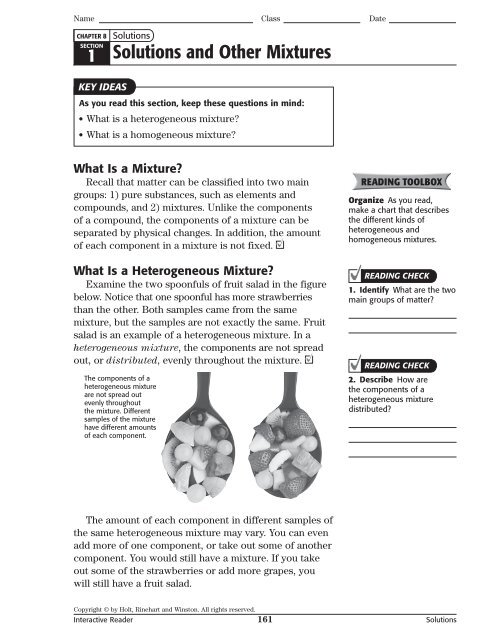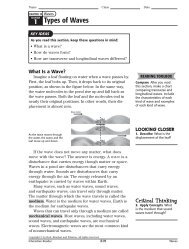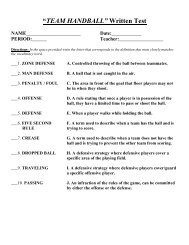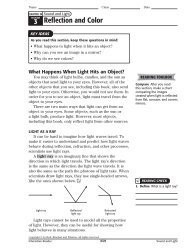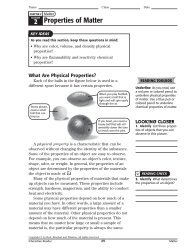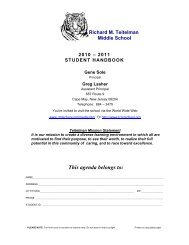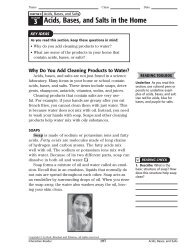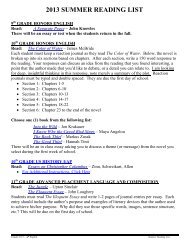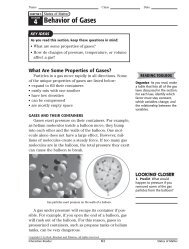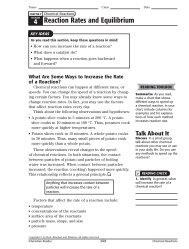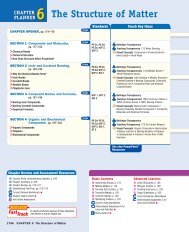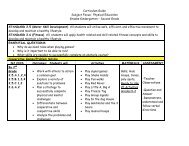1 Solutions and Other Mixtures
1 Solutions and Other Mixtures
1 Solutions and Other Mixtures
- No tags were found...
Create successful ePaper yourself
Turn your PDF publications into a flip-book with our unique Google optimized e-Paper software.
Name Class DateCHAPTER 8SECTION<strong>Solutions</strong>1 <strong>Solutions</strong> <strong>and</strong> <strong>Other</strong> <strong>Mixtures</strong>KEY IDEASAs you read this section, keep these questions in mind:• What is a heterogeneous mixture?• What is a homogeneous mixture?What Is a Mixture?Recall that matter can be classified into two maingroups: 1) pure substances, such as elements <strong>and</strong>compounds, <strong>and</strong> 2) mixtures. Unlike the componentsof a compound, the components of a mixture can beseparated by physical changes. In addition, the amountof each component in a mixture is not fixed.What Is a Heterogeneous Mixture?Examine the two spoonfuls of fruit salad in the figurebelow. Notice that one spoonful has more strawberriesthan the other. Both samples came from the samemixture, but the samples are not exactly the same. Fruitsalad is an example of a heterogeneous mixture. In aheterogeneous mixture, the components are not spreadout, or distributed, evenly throughout the mixture.The components of aheterogeneous mixtureare not spread outevenly throughoutthe mixture. Differentsamples of the mixturehave different amountsof each component.READING TOOLBOXOrganize As you read,make a chart that describesthe different kinds ofheterogeneous <strong>and</strong>homogeneous mixtures.READING CHECK1. Identify What are the twomain groups of matter?READING CHECK2. Describe How arethe components of aheterogeneous mixturedistributed?The amount of each component in different samples ofthe same heterogeneous mixture may vary. You can evenadd more of one component, or take out some of anothercomponent. You would still have a mixture. If you takeout some of the strawberries or add more grapes, youwill still have a fruit salad.Copyright © by Holt, Rinehart <strong>and</strong> Winston. All rights reserved.Interactive Reader 161 <strong>Solutions</strong>
Name Class DateSECTION 1<strong>Solutions</strong> <strong>and</strong> <strong>Other</strong> <strong>Mixtures</strong> continuedSUSPENSIONSHave you ever forgotten to shake the orange juicecarton? When you poured yourself a glass of orange juice,it was probably watery. Orange juice is a heterogeneousmixture. Shaking the mixture mixes the components ofthe orange juice. However, eventually the mixture willsettle again into layers.Orange juice is an example of a suspension. In asuspension, the components that make up the mixturemay seem to be distributed almost evenly. However,when the mixture is allowed to sit, one component settlesto the bottom. When orange juice sits for a while, thepulp settles to the bottom of the container.Right after you shake thejuice, the pulp is spreadthroughout the mixture.LOOKING CLOSER3. Explain What happens tothe particles in a suspensionover time?Over time, the pulpsettles out of the mixture,<strong>and</strong> two layers form.READING CHECK 4. Explain Why is itgenerally easy to filter outparticles in suspension?Particles in a suspension are large enough to befiltered out of the mixture. For example, to remove thepulp from orange juice, you can pour the juice through afilter of porous paper. This filter will catch the pulp butwill let the juice pass through.SuspensionsParticles are relatively large.Particles settle out or can be filtered.Copyright © by Holt, Rinehart <strong>and</strong> Winston. All rights reserved.Interactive Reader 162 <strong>Solutions</strong>
Name Class DateSECTION 1<strong>Solutions</strong> <strong>and</strong> <strong>Other</strong> <strong>Mixtures</strong> continuedLIQUIDS IN SUSPENSIONMany suspensions, such as orange juice, are a mixtureof a liquid <strong>and</strong> a solid. However, some mixtures are madeup of two liquids. For example, you can combine oil,vinegar, <strong>and</strong> spices to make salad dressing. If you shakethe ingredients, they will mix. However, if the dressingsits for a while, the liquids will separate into layers.Why? Oil <strong>and</strong> vinegar are immiscible. Liquids that areimmiscible do not mix or do not stay mixed.Many salad dressings are madeof oil <strong>and</strong> vinegar, which form asuspension when shaken. Oil isless dense than vinegar. Whenthe salad dressing sits for awhile, the oil rises <strong>and</strong> floatson top of the vinegar.READING CHECK5. Define What areimmiscible liquids?6. Explain Why does the oilrise above the vinegar?COLLOIDSColloids are another type of heterogeneous mixture.Like a suspension, a colloid has particles dispersedthroughout the mixture. However, the particles of acolloid are smaller than the particles of a suspension.The particles of colloids are so small that they canpass through most filters <strong>and</strong> remain spread throughoutthe mixture.Latex paint is an example of a colloid. The color inlatex paint comes from particles of colored pigmentsin water. Gelatin, egg whites, <strong>and</strong> blood plasma are allexamples of colloids. Whipped cream is a colloid madeby dispersing gas in a liquid. Fog is a colloid of waterdroplets in air. Smoke is a colloid of small solid particlesin air.7. Compare What is themain difference between asuspension <strong>and</strong> a colloid?ColloidsParticles are relatively small.Particles cannot be filtered easily.Copyright © by Holt, Rinehart <strong>and</strong> Winston. All rights reserved.Interactive Reader 163 <strong>Solutions</strong>
Name Class DateSECTION 1<strong>Solutions</strong> <strong>and</strong> <strong>Other</strong> <strong>Mixtures</strong> continued8. Describe What is theTyndall effect?The liquid in the jar onthe right is a colloid. Acolloid may look clear,but the particles may belarge enough to scatterlight. This scatteringof light is called theTyndall effect.READING CHECKEMULSIONSAn emulsion is a colloid made of liquids that aregenerally immiscible. Mayonnaise is made of tinydroplets of oil suspended in vinegar. Unlike the oil<strong>and</strong> vinegar of salad dressing, the oil <strong>and</strong> vinegar inmayonnaise stay mixed because of egg yolks. Eggyolks act as an emulsifier. An emulsifier coats onetype of particles in the mixture so that they cannot jointo form a separate layer.9. Explain How is anemulsion different fromother colloids?Like other colloids, an emulsion, such as cream, has particlesso small that the mixture looks like a pure substance. However,cream is a mixture of fats, proteins, <strong>and</strong> carbohydratesdispersed in water. Proteins act as emulsifiers to coat thedroplets of fats <strong>and</strong> keep them dispersed.EmulsionsAn emulsion is a colloid made ofimmiscible liquids.Emulsifiers keep layers fromseparating.Copyright © by Holt, Rinehart <strong>and</strong> Winston. All rights reserved.Interactive Reader 164 <strong>Solutions</strong>
Name Class DateSECTION 1<strong>Solutions</strong> <strong>and</strong> <strong>Other</strong> <strong>Mixtures</strong> continuedWhat Is a Homogeneous Mixture?In a homogeneous mixture, the particles are dispersedevenly throughout. In other words, a homogeneousmixture is uniform. A sample from one part of ahomogeneous mixture is the same as any other sampleof the mixture. A homogeneous mixture looks uniformeven under a microscope.If you stir a small amount of salt into water, the mixturewill look like pure water. Every part of the mixture hasthe same relative amounts of salt <strong>and</strong> water particles. Likeany mixture, a mixture of salt <strong>and</strong> water can be separatedphysically into its components. The components of amixture also keep their separate identities. Thus, you canseparate the salt from the mixture by evaporating the water.READING CHECK10. Describe How arethe components of ahomogeneous mixturedistributed?11. Label Usehomogeneous mixture<strong>and</strong> heterogeneous mixtureto label the diagrams.SOLUTIONS<strong>Solutions</strong> are homogeneous mixtures. A solution is ahomogenous mixture in which one or more componentsdissolves in another. For examples, if you stir salt intowater, the salt dissolves in the water <strong>and</strong> seems todisappear. What happens to the salt when it dissolves?When a substance dissolves, it separates into thesmallest particles that make up the substance. Theseparticles may be atoms, ions, or molecules. For example,in water, salt separates into Na + <strong>and</strong> Cl − ions. In thissolution, salt is called the solute. A solute is thesubstance that dissolves. In a saltwater solution,water is the solvent. A solvent is the substancein which the solute dissolves. Together, a solute<strong>and</strong> solvent make up a solution.READING CHECK12. Describe Whathappens to a substancewhen it dissolves?Copyright © by Holt, Rinehart <strong>and</strong> Winston. All rights reserved.Interactive Reader 165 <strong>Solutions</strong>
Name Class DateSECTION 1<strong>Solutions</strong> <strong>and</strong> <strong>Other</strong> <strong>Mixtures</strong> continuedWater is a pure substance.13. Identify Into what smallparticles does salt separatewhen it dissolves? 14. Apply Concepts Whatkind of mixture is the gravelat the bottom of the fishtank?Saltwater is a homogeneousmixture. The water molecules,sodium ions, <strong>and</strong> chlorideions are distributed evenlythroughout the mixture.<strong>Solutions</strong>One substance dissolves in another.Solute separates into atoms, ions,or molecules when it dissolves.READING CHECKSOLUTIONS OF LIQUIDSA solution may be made up of liquids. Two or moreliquids that mix easily <strong>and</strong> stay mixed are miscible. Forexample, water mixes with isopropanol to form asolution called rubbing alcohol. Water <strong>and</strong> isopropanolare miscible, so they stay mixed. You can use rubbingalcohol to disinfect cuts <strong>and</strong> scrapes.15. Define What doesmiscible mean?Window cleaner, rubbingalcohol, <strong>and</strong> gasoline areall mixtures of liquidsCopyright © by Holt, Rinehart <strong>and</strong> Winston. All rights reserved.Interactive Reader 166 <strong>Solutions</strong>
Name Class DateSECTION 1<strong>Solutions</strong> <strong>and</strong> <strong>Other</strong> <strong>Mixtures</strong> continuedOTHER KINDS OF SOLUTIONSWater is not the only liquid that can be a solvent. Forexample, gasoline is a homogeneous mixture of liquidsthat contains no water. Nail polish remover is anothersolution that contains no water.<strong>Other</strong> states of matter can also form solutions. Gasescan dissolve in liquids, <strong>and</strong> solids can dissolve in solids.For example, many carbonated drinks are solutions of agas (carbon dioxide), a liquid (water), <strong>and</strong> a solid (sugar).ALLOYSAn alloy is a homogeneous mixture that is made upof two or more metals. Liquid metals are mixed together,<strong>and</strong> a solid solution of metals forms when the mixturecools.Alloys are important because they have properties thatthe individual metals do not have. For example, copper isvery soft <strong>and</strong> bends easily. Copper could not be used tomake a sturdy musical instrument. However, when zincis dissolved in copper, the brass that forms is harder thancopper, but bends more easily than zinc.16. Apply Concepts Whatstates of matter are presentin a seawater solution? Giveexamples of each state.READING CHECK17. Explain Why are alloyssometimes more useful thanpure metals?Some solutions are made of two or more metals. For example, brass is asolution of zinc metal dissolved in copper.AlloysAn alloy is one or more metalsdissolved in another.Properties differ from those of theindividual metals.Copyright © by Holt, Rinehart <strong>and</strong> Winston. All rights reserved.Interactive Reader 167 <strong>Solutions</strong>
Name Class DateSection 1 ReviewSECTION VOCABULARYalloy a solid or liquid mixture of two or moremetalscolloid a mixture consisting of tiny particles thatare intermediate in size between those in solutions<strong>and</strong> those in suspensions <strong>and</strong> that aresuspended in a liquid, solid, or gasemulsion any mixture of two or more immiscibleliquids in which one liquid is dispersed inthe othersolute in a solution, the substance that dissolvesin the solventsolution a homogenous mixture throughoutwhich two or more substances are uniformlydispersedsolvent in a solution, the substance in which thesolute dissolvessuspension a mixture in which particles of amaterial are more or less evenly dispersedthroughout a liquid or gas1. Compare What is the main difference between a heterogeneous <strong>and</strong> ahomogeneous mixture?2. Organize Complete the concept map to show the relationships between alloys,colloids, emulsions, heterogeneous mixtures, homogeneous mixtures, matter,mixtures, pure substances, solutions, <strong>and</strong> suspensions.<strong>Mixtures</strong>EmulsionsAlloys3. Apply Concepts You suspect that a clear liquid is actually a colloid. How couldyou find out?4. Apply Concepts Imagine you have dissolved a small amount of baking soda in aglass of water. Identify the solute <strong>and</strong> solvent.Copyright © by Holt, Rinehart <strong>and</strong> Winston. All rights reserved.Interactive Reader 168 <strong>Solutions</strong>


